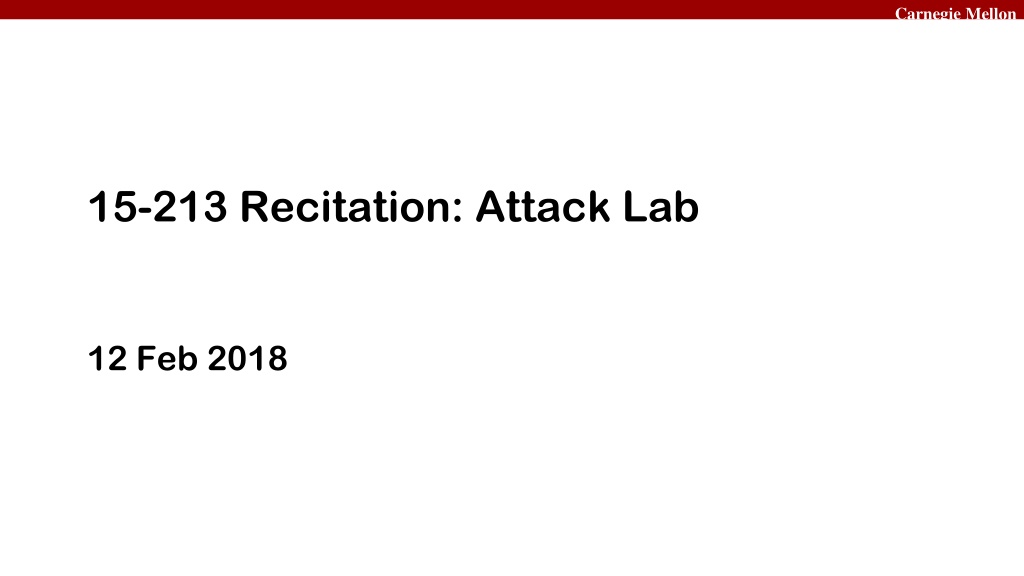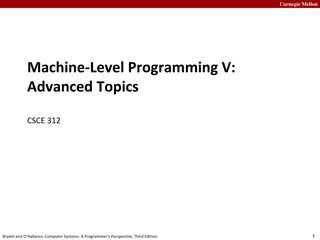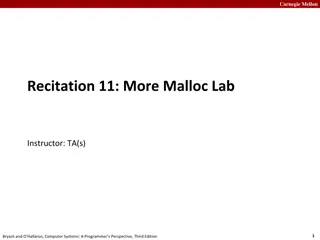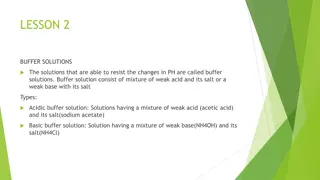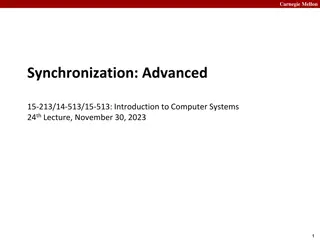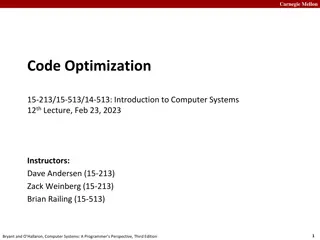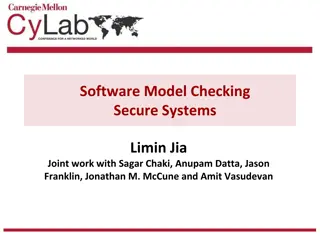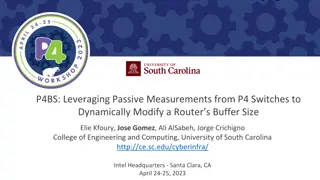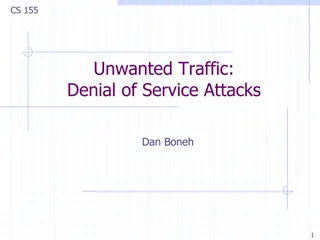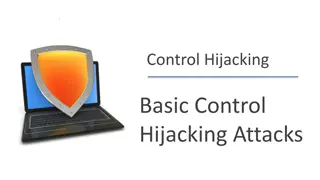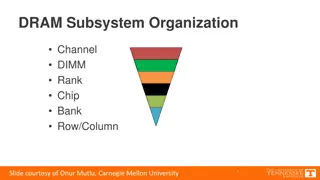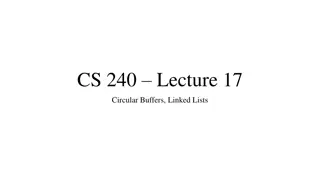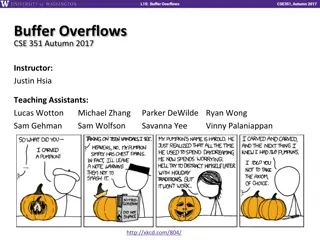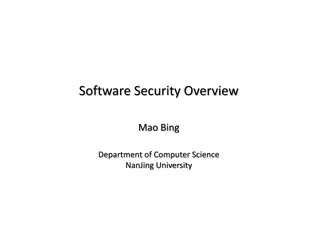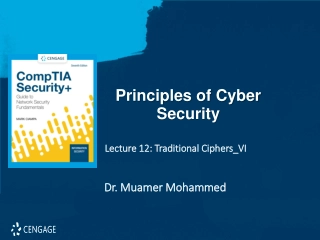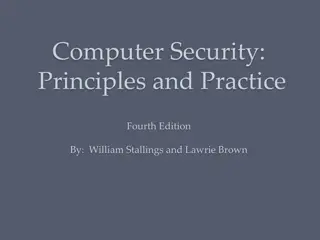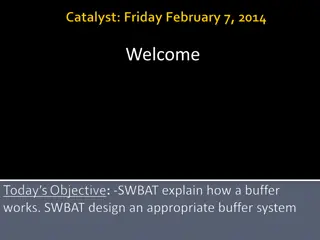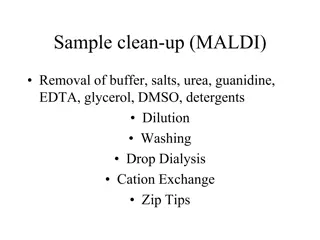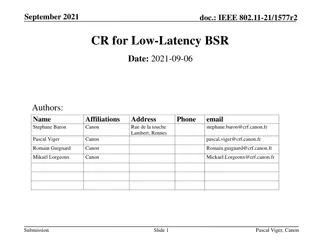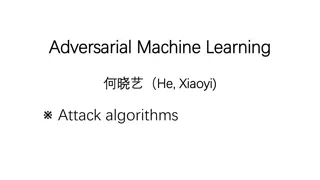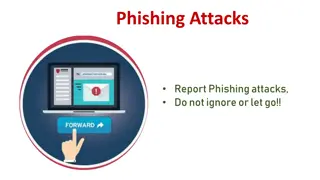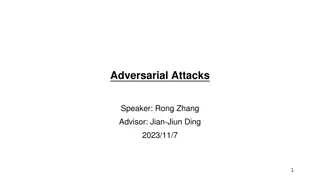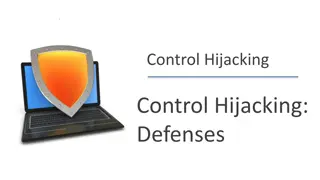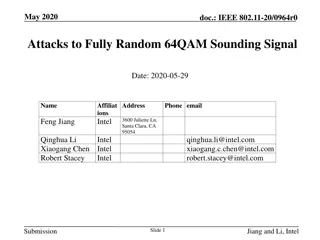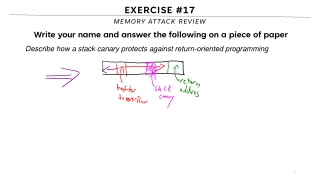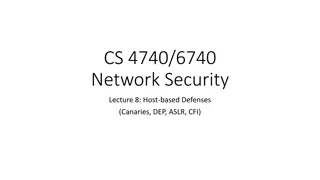Understanding Buffer Overflow Attacks at Carnegie Mellon
Learn about the Carnegie Mellon 15-213 Recitation Attack Lab, where you can hijack programs using buffer overflow attacks. Gain insights into stack discipline, stack frames, and defeating secure programs through return-oriented programming. Dive into topics like stack smashing attacks, buffer overflows, and executing commands on the stack. Explore countermeasures against executable code on the stack and alternative strategies for exploitation.
Download Presentation

Please find below an Image/Link to download the presentation.
The content on the website is provided AS IS for your information and personal use only. It may not be sold, licensed, or shared on other websites without obtaining consent from the author. Download presentation by click this link. If you encounter any issues during the download, it is possible that the publisher has removed the file from their server.
E N D
Presentation Transcript
Carnegie Mellon 15-213 Recitation: Attack Lab 12 Feb 2018
Carnegie Mellon Agenda Reminders Buffer Overflow Attacks Attack Lab Activities
Carnegie Mellon Reminders Bomb lab is due tomorrow (13 Feb, 2018)! Don t waste your grace days on this assignment Attack lab will be released tomorrow Start early!! (no more penalties for mistakes like bomb lab)
Carnegie Mellon Attack Lab We re letting you hijack programs by running buffer overflow attacks on them To understand stack discipline and stack frames To defeat relatively secure programs with return oriented programming
Carnegie Mellon Stack Smashing Attack Callq pushes the return address onto the stack Retq pops this return address and jumps to it Next return address $rsp
Carnegie Mellon Buffer Overflows Local string variables are stored on the stack C functions do not do size checking of strings Next return address Space allocated for string $rsp
Carnegie Mellon Buffer Overflows You can write a string that overwrites the return address Activity 1 steps through an example of overwriting the return address on the stack Extra long string input Next return address Space allocated for string $rsp
Carnegie Mellon Executing Commands on the Stack What if instead of jumping to a predefined function, we jumped to code on the stack? Activity 2 steps through an example of executing code on the stack Assembly instructions on the stack Return address points to assembly above $rsp
Carnegie Mellon OS Countermeasures Executable code is not allowed on the stack (unless we specifically allow it e.g. through mprotect like we do for activity 2) Thus, we have to use executable code already in the program to do what we want But code often doesn t already contain our exploit function so what can we do instead?
Carnegie Mellon Return-Oriented Programming Goal: execute a small section of code, return, call another small section of code. Repeat until you execute your exploit Activity 3 steps you through an example of a return oriented programming exploit
Carnegie Mellon Attack Lab Activities Three activities Each relies on a specially crafted assembly sequence to purposefully overwrite the stack Activity 1 Overwrites the return addresses (Buffer Overflow) Activity 2 Writes assembly instructions onto the stack Activity 3 Uses byte sequences in libc as the instructions (Return-Oriented Programming)
Carnegie Mellon Attack Lab Activities Work in pairs: one student needs a laptop Login to a shark machine $ wget http://www.cs.cmu.edu/~213/activities/rec4.tar $ tar xf rec4.tar $ cd rec4 $ make $ gdb act1
Carnegie Mellon Activity 1 (gdb) break clobber (gdb) run (gdb) x $rsp (gdb) backtrace Q. Does the value at the top of the stack match any frame? A. 0x400553 is the address to return to in main
Carnegie Mellon Activity 1 Continued (gdb) x /2gx $rdi (gdb) stepi // Here are the two key values // Keep doing this until (gdb) clobber () at support.s:16 16 ret (gdb) x $rsp Q. Has the return address changed? A. 0x400500 was the first number pointed to by $rdi (gdb) finish // Should exit and print out Hi!
Carnegie Mellon Activity 1 Post Clobber overwrites part of the stack with memory at $rdi, including the all-important return address In act1, it writes two new return addresses: 0x400500: address of printHi() 0x400560: address in main Call clobber() Clobber executes In printHi() In main() ret 0x000000400560 ret 0x7fffffffe338 0x000000400560 0x000000400553 0x000000400500
Carnegie Mellon Activity 2 $ gdb act2 (gdb) break clobber (gdb) run (gdb) x $rsp Q. What is the address of the stack and the return address? A. 0x7fffffffe018 -> 0x40058a (gdb) x /4gx $rdi Q. What will the new return address be?
Carnegie Mellon Activitity 2 Continued (gdb) x /5i $rdi + 8 // Display as instructions Q. Why $rdi + 8? A. Want to ignore the 8-byte return address Q. What are the three addresses? A. 0x48644d, 0x4022e0, 0x4011a0 (gdb) break puts (gdb) break exit Q. Do these addresses look familiar? A. puts 0x4022e0, exit 0x4011a0
Carnegie Mellon Activity 2 Post Normally programs cannot execute instructions on the stack Main used mprotect to disable the memory protection for this activity Clobber wrote an address that s on the stack as a return address Followed by a sequence of instructions Three addresses show up in the exploit: 0x48644d Hi\n string 0x4022e0 puts() function 0x4011a0 exit() function
Carnegie Mellon Activity 3 $ gdb act3 (gdb) break clobber (gdb) run (gdb) x /5gx $rdi Q. Which value will be first on the stack? Why is this important? A. 0x457d0c, this is the address to return to from clobber
Carnegie Mellon Activity 3 Continued (gdb) x /2i <return address> Q. What does this sequence do? A. Pops next stack value into $rdi, then returns Q. Check the other addresses. Note that some are return addresses and some are for data. When you continue, what will the code now do? A. Print Hi\n
Carnegie Mellon Activity 3 Post It s harder to stop programs from running existing pieces of code in the executable. Clobber wrote multiple return addresses (aka gadgets) that each performed a small task, along with data that will get popped off the stack while running the gadgets. 0x457d0c: pop %rdi; retq 0x47fa64: Pointer to the string Hi\n 0x429a6a: pop %rax; retq 0x400500: Address of a printing function 0x47f001: callq *%rax
Carnegie Mellon Activity 3 Post Note that some of the return addresses actually cut off bytes from existing instructions 0x457d0b 0c 0d ----------------------------------------- pop %r15 41 5f retq c3 pop %rdi retq c3 5f
Carnegie Mellon If you get stuck Please read the writeup! CS:APP Chapter 3 View lecture notes and course FAQ at http://www.cs.cmu.edu/~213 Office hours Sunday through Thursday at 5:00-9:00 in WH 5207, Friday at 3:00-5:00 in Gates Commons Post a private question on Piazza man gdb gdb's help command
Carnegie Mellon Attack Lab Tools gcc gcc c c test.s test.s; ; objdump Compiles the assembly code in test.s and shows the actual bytes for the instructions objdump d d test.o test.o > test.asm > test.asm ./hex2raw < exploit.txt > converted.txt ./hex2raw < exploit.txt > converted.txt Convert hex codes in exploit.txt into raw ASCII strings to pass to targets See the writeup for more details on how to use this ( (gdb gdb) ) display /12gx $ display /12gx $rsp Displays 12 elements on the stack and the next 2 instructions to run rsp ( (gdb gdb) ) display /2i $rip display /2i $rip GDB is also useful for tracing to see if an exploit is working
